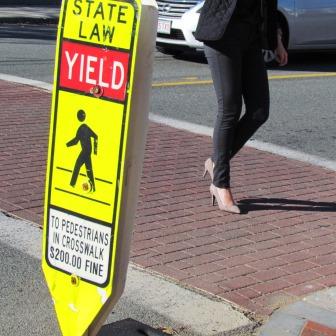
Pedestrian accidents kill as many as five thousand people on the highways and streets of the USA every year.
National Highway Traffic Safety Administration (NHTSA) statistics also indicate approximately 65,000 pedestrians are injured each year in motor vehicle related accidents.
The numbers also reveal that a shocking 48% of pedestrian deaths in such accidents were caused by drunk drivers. Pedestrian deaths represent 15% of all motor vehicle accident related deaths. According to the Centers for Disease Control and Prevention, motor vehicle accidents are the leading cause of unintentional deaths in the U.S. with more than 33 thousand deaths each year.
What Are Common Causes of Pedestrian Accidents?
While pedestrians sometimes cause their own problems vehicles are often at fault. All too often distracted drivers fail to be attentive and alert, presenting high risk to other drivers and pedestrians. Most pedestrian accidents occur due to distracted driving. Between eating, talking on the phone, texting, adjusting the radio, or entering data into a GPS, a driver’s eyes are not always completely focused on the roadway, as they should be. Other causes of pedestrian deaths include;
- Speeding
- Failure to slow down for pedestrians in a crosswalk
- Failure to use turn signals
- Failure to obey traffic signals
- Drunk Driving
- Failure to drive safely considering weather conditions
Many driver distractions cause accidents every day. We summarized some of the dangers in a previous blog article. A car driving at highway speed can travel the length of a football field while the driver looks down for only 4 ½ seconds to read a text.
Pedestrian Duties
Pedestrians should always be aware of bad drivers when they walk anywhere near streets and highways, especially when crossing the street. That’s common sense. At the same time, pedestrians have their own duty to walk in a reasonably safe manner and to avoid danger. These legal duties include not jaywalking, waiting for crossing signals at intersections, looking both ways, and waiting to walk until a driver is completely stopped or checking to make sure the roadway is clear before walking.
Compensation for Pedestrian Accident Injuries
Most states require all motorists on the roadways to insure their vehicles. Therefore, when a pedestrian is struck by a motorist, they can likely pursue the motorist’s insurance for a liability claim. However, before receiving compensation for pain and suffering, the injured pedestrian must prove fault before the insurance company will accept the claim. “No-fault” coverage exists in many states and the particulars vary by state. However, in Massachusetts, the “PIP” No-fault coverage on the vehicle which strikes a pedestrian is liable to pay up to $8,000 in the injured pedestrian’s medical bills and lost wages. More on “No Fault” insurance here.
Proving Negligence in a Pedestrian Accident
In a claim or civil lawsuit to recover for pain and suffering injuries, the pedestrian must prove the driver’s negligence was responsible for the accident and related injuries. To prove the negligent motorist is at fault, the injured party must prove that the motorist owed a legal duty to the injured pedestrian, that the motorist breached their legal duty and that the motorist’s negligence caused provable injuries. Evidence often used to prove the elements of a pedestrian’s negligence claim can include photographs of the accident scene, photos of the car, any available surveillance video, witness statements and accident reports. Accident reports themselves are often inadmissible in court as hearsay evidence, but police reports and other accident reports can be helpful in locating evidence which may be admissible.
Negligence by Pedestrians
In areas where the pedestrians have the right-of-way such as crosswalks, drivers are expected to yield. However, when the pedestrian doesn’t have the right-of-way and an accident occurs, the pedestrian can be found liable for the accident. If the pedestrian caused the accident, the pedestrian will not be able to recover any compensation since no one else is to blame. Pedestrians can be found at fault at least partially for the accident and often cause their own injures due to inattention to traffic patterns, “do-not-walk” signals, jaywalking, darting in front of traffic, walking in prohibited areas such as interstates, walking while intoxicated by drugs or alcohol, and not yielding to drivers while in the crosswalk that are too close to stop and yield to the pedestrian.
Shared Fault
Even where pedestrians are at least in part responsible for their own injuries, the driver of the vehicle that hit them is also at least partially at fault for the accident occurs. For example, if a driver is texting while driving, accidentally veers out of the lane and hits a pedestrian, the driver is at least partially liable. If the pedestrian was walking in a prohibited area as discussed above, then the pedestrian will share fault in the final analysis. When there is blame on both sides, where both the pedestrian and the driver share the fault for the pedestrian accident, the laws that apply in determining who pays is called comparative fault or contributory negligence. These laws vary from state-to-state and are the subject of a different blog article. Essentially the comparative fault concept gives the injured pedestrian the ability to receive compensation for all damages, but the amount awarded to them, the amount the insurance must pay, is reduced by the percentage that they were found to be at fault. Under the contributory negligence theory in many states, the injured victim collects damages as long as the victim is found less than 50 percent at fault for their own injuries.
Pedestrian Accidents: Conclusion
Distracted drivers present one of the major threats to the safety of pedestrians. Texting, talking on the cell phone, even drinking a cup of coffee while driving are all documented causes of pedestrian accidents and fatalities. At the same time, distracted pedestrians and people who jaywalk, cross streets against the signals and who otherwise don’t follow the rules can also cause their own injuries. When neither the motor vehicle operator nor the pedestrian is attentive and following the rules, the likelihood of injury increases.
Sources Traffic Safety Facts, Pedestrians, NHTSA, published May, 2016. Motor Vehicle Traffic-Related Pedestrian Deaths, Centers for Disease Control and Prevention, published April 19, 2013.
Visits: 421




